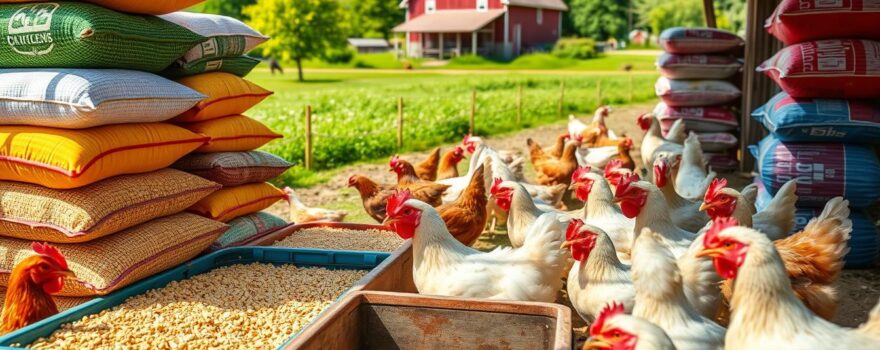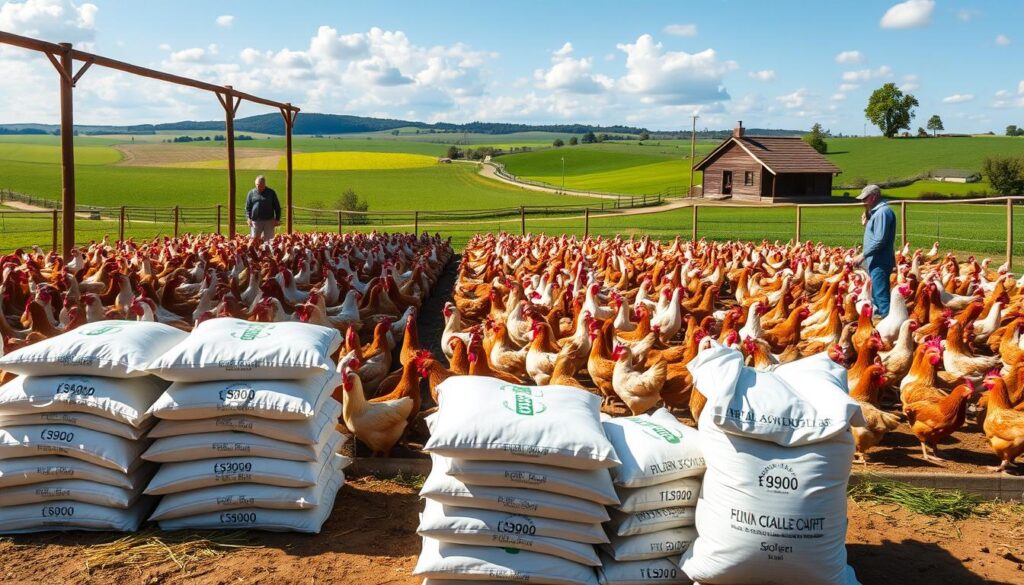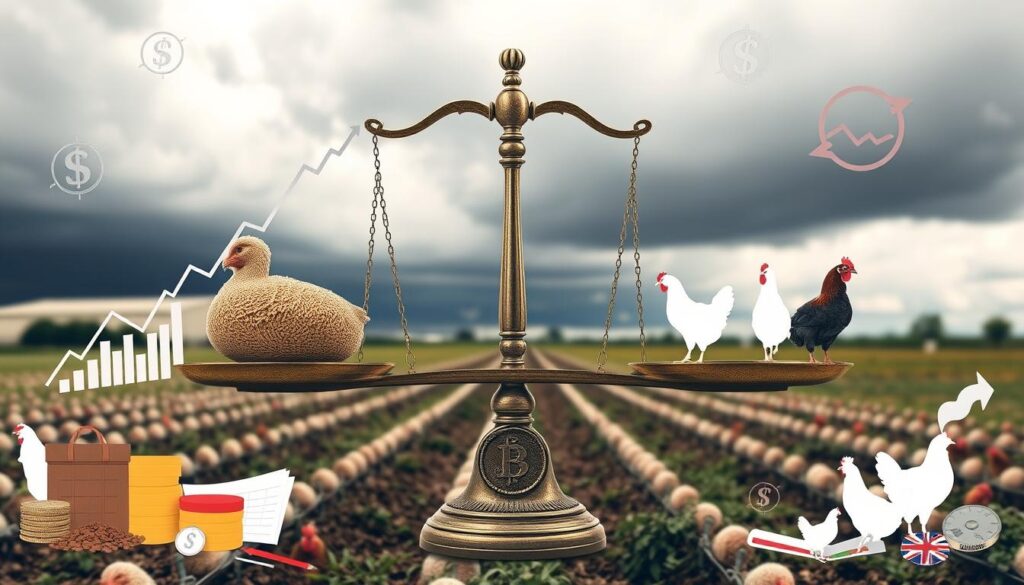
In the poultry industry, feed costs make up about 70% of the total cost of raising broiler chickens. Poultry feed is a mix of grains, protein, vitamins, minerals, and additives. The exact mix depends on the bird’s genetics, age, and environment.
Many feed ingredients face price changes due to weather, shipping costs, and crop quality. As farms cut back on antibiotics and meet new consumer needs, costs will likely go up. This could hurt the profits of broiler chicken farms a lot.
Key Takeaways
- Feed costs account for up to 70% of the total production cost in broiler chicken farming.
- Fluctuations in the prices of feed ingredients, such as grains and protein supplements, can significantly impact the profitability of broiler chicken farms.
- As producers work to reduce antibiotic use and meet changing consumer preferences, production costs are expected to rise, further squeezing profit margins.
- Efficient feed cost management, including optimizing feed formulations and improving feed efficiency, is crucial for maintaining the profitability of broiler chicken operations.
- Monitoring and managing other key cost factors, such as water quality and chick/poult quality, can also help broiler chicken farms optimize their profitability.
Primary Costs in Poultry Production
Role of Feed Costs
Feed costs are a big part of the expenses in the poultry industry. Experts say feed costs are about 60-70% of the total cost for raising broiler chickens. The feed includes grains, protein, vitamins, minerals, and additives that help the birds grow and stay healthy.
The prices of these feed components can change a lot. Weather, freight, and crop quality can all affect these prices. This can make it harder for broiler chicken farms to stay profitable.
As people want less antibiotics in their chicken, costs are going up. Farmers need to find ways to keep their feed costs down. They must also find ways to stay competitive.
“Feed costs account for the largest share of the total cost in broiler production, making it a crucial factor in determining the overall profitability of the farm.”
Broiler chickens need 1.75 kilograms of feed to gain 1 kilogram of weight. They usually weigh about 2.25 kilograms and are sold at 38.9 days old. This shows how important it is to use feed wisely to make a profit.
Factors Influencing Poultry Production Costs
The poultry industry is changing to meet consumer needs. This change makes managing costs harder. Reducing antibiotic use and changing how birds are raised can be costly. The nutrition and live production teams must keep the birds healthy and safe for food.
Recent studies have found several important factors affecting poultry production costs:
- Decisions about antibiotics in feed can raise costs. Producers look for new ways to keep their birds healthy.
- Changes in how birds are raised, like cage-free or free-range, increase costs. This includes more money for buildings, workers, and running the farm.
- Consumer demands for “clean label” or organic products lead to changes in how birds are fed and processed. These changes cost money.
As the poultry industry deals with these changes, producers must balance animal care, customer needs, and profit. They need to be efficient, innovative, and understand the factors impacting poultry production costs. This includes the changes in poultry production systems and the impact of consumer demands on production costs.
“The short production cycle of broiler production (approximately 42 days) emphasizes the importance of efficient management practices and the need for timely corrections of issues to ensure good performance.”
Strategies to Lower Production Costs
Poultry production costs are going up, and farmers need to find ways to cut expenses. By using cost-saving methods, farmers can make more money and keep their farms running well. Let’s look at some good ways to lower costs in the poultry industry.
Improving Feed Quality and Efficiency
Feed is a big part of the cost, making up 40% to 70% of expenses. Making feed better and using it more efficiently can save a lot. Farmers can save by making their own feed, watching how much is eaten, and feeding at the right times, especially when it’s hot.
Enhancing Water Quality and Consumption
Good water is key for healthy birds. Better water quality and use can lead to better growth and fewer sick birds. Keeping water lines clean and using the right water treatment systems are important steps.
Addressing Early Mortality in Flocks
High death rates in young birds can really hurt costs. Keeping the farm clean, raising birds right, and controlling diseases can help. This keeps the birds healthy and reduces death rates.
Improving Chick and Poult Quality
The health of day-old chicks and poults is very important. Better genetics, proper incubation, and good parent stock can lead to healthier birds. This means better growth and lower costs.
| Strategies | Potential Impact |
|---|---|
| Improving feed quality and efficiency | Reduce feed costs by 40-70% |
| Enhancing water quality and consumption | Improve feed conversion ratio and reduce mortality |
| Addressing early mortality in flocks | Minimize losses and improve overall flock productivity |
| Improving chick and poult quality | Enhance growth performance and reduce production costs |
By using these strategies, poultry farmers can lower costs, make more money, and keep their farms going strong.
The Impact of Feed Costs on Broiler Chicken Farming Profitability
Feed costs are key to making money in broiler chicken farming. Cutting feed costs per ton might seem smart. But, it’s vital to think about how it affects the farm’s overall success and profits.
Studies show that lowering feed nutrient levels to save money can hurt farm performance and profits. For instance, a trial with birds on a diet with 90% of the needed protein levels saved on feed costs. Yet, the farm’s performance and profit per bird or kilogram of weight went down. This shows the need to balance saving on feed with keeping production high.
The aim should be to make the most difference between what you earn and what you spend on feed. This way, you get the best profit by improving the link between feed costs and farm margins. By balancing feed cost reduction and production performance, broiler chicken farmers can have the biggest impact on their farm’s profitability.
| Key Factor | Impact on Profitability |
|---|---|
| Reducing feed nutrient levels | Decreased farm performance and overall margins |
| Maximizing difference between revenue and feed costs | Ensures highest profitability |
| Balancing feed cost reduction and production performance | Greatest impact on farm profitability |
Understanding how feed costs affect broiler chicken farm profitability helps farmers make better choices. This way, they can improve their operations and increase their earnings.
Balanced Protein and Energy Optimization
Balanced Protein Concept
Broiler chickens need a lot of protein in their diet. Protein is also very expensive. To make broilers grow well and be profitable, it’s key to use the right amount of protein.
The “balanced protein” idea uses the Ideal Amino Acid profile. This means knowing the right amount of each amino acid in the feed. Soybean meal, a common protein source, has 40-48% crude protein.
Animal proteins like poultry and fish have more protein and important amino acids. They also have phosphorus and some energy. Adding these to broiler feed can help them grow better.
But, plant proteins are cheaper but lack some amino acids. To fix this, adding synthetic amino acids can help. This makes feed more efficient and cheaper. The goal is to get the right mix of amino acids in broiler feed for better growth and profit.
| Nutrient | Minimum Level | Maximum Level |
|---|---|---|
| Crude Protein | 18% | 24% |
| Lysine | 1.00% | 1.20% |
| Methionine | 0.50% | 0.60% |
| Calcium | 0.90% | 1.10% |
| Available Phosphorus | 0.45% | 0.55% |
By getting the protein and energy levels just right in broiler feed, farmers can make their broilers grow well and be profitable.
Contract Broiler Grower Income
In the poultry industry, contract broiler grower households make more money than most. In 2021, their median income was $68,455. This is more than the $57,050 for all farm households and $50,504 for all U.S. households. A big 60% of these growers made more than the national median.
This shows contract broiler growers have a financial edge. The poultry industry has grown a lot, with broiler production increasing by 2% each year since 2000. This steady growth means there’s always a demand for these growers, giving them a stable income.
The success of these growers comes from the efficiency of modern poultry farming. Starting a broiler farm costs a lot, almost $6 million for a new eight-barn facility. But the benefits of being big and the help from integrators keep them profitable.
| Household Type | Median Income (2021) |
|---|---|
| Contract Broiler Growers | $68,455 |
| All Farm Households | $57,050 |
| All U.S. Households | $50,504 |
Contract broiler growers earn more because the industry is stable and profitable. They also get support and resources from the integrators they work with. This makes contract broiler production a good and rewarding career choice in the poultry industry.

Variations in Grower Incomes
The income of contract broiler growers can vary a lot. Several factors influence this variation. One important factor is off-farm income, which can greatly impact a grower’s total earnings.
Research indicates that the income range among contract broiler growers is wider than for all farm and U.S. households. The 80th percentile for contract growers was $143,294, higher than the other groups. Yet, the 20th percentile for contract growers was $18,782, lower than the others.
Off-Farm Income
Off-farm income is key for many contract broiler growers. They often need extra income to support their living standards. This can come from other farming activities, jobs, or investments.
The influence of off-farm income shows the varied financial situations of contract broiler growers. While some earn well, others face challenges making enough from their poultry operations alone.
“The spread of household incomes is much greater among contract broiler growers compared to all farm households and all U.S. households.”
Contract Fee Structures
In the broiler chicken farming industry, contract broiler production fees are not fixed per pound of chickens. Instead, they follow a tournament-style payment system. Growers earn based on how they compare to others delivering chickens at the same time.
This system aims to push growers to work more efficiently and cut costs. The main factors affecting grower fees are how well the chickens grow, production costs, and the birds’ weight when delivered.
Contracts might also offer extra payments for things like low mortality rates and healthy flocks. Growers who do better than others can get more money per pound. Those who don’t perform as well might get less.
Contracts can last from over a month to 15 years, depending on the deal. Growers need to understand the contract’s end terms well. This is because integrators often have more say in ending the contract.
It’s key for broiler growers to grasp the contract broiler production fees and the tournament-style payment system. This knowledge helps them make more money and handle the factors affecting grower fees well.
“The broiler industry has been dealing with poultry diseases and biosecurity issues for many years, which can significantly impact grower fees and overall profitability.”
Risks and Rewards of Contract Production
The contract broiler production system aims to reward low-cost production. However, it introduces new financial risks for growers. The payment system, based on relative performance, can cause a wide league-composition risk in grower incomes.
In 2011, the median income for contract broiler growers was $68,455. This is higher than the $50,504 for all U.S. households and $57,050 for farm households. The income distribution is more unequal, with the 80th percentile at $143,294 and the 20th percentile at $18,782.
The financial risks in contract broiler production come from the impact of tournament-style payment system. Growers are paid based on the pounds of usable broilers produced. The top performers earn over 7 cents per pound, while the bottom 10% earn less than 4.32 cents. Factors like chick mortality, feed conversion, and production practices greatly affect a grower’s relative performance and income.
| Metric | Value |
|---|---|
| Median income for contract broiler growers (2011) | $68,455 |
| Median income for all U.S. households (2011) | $50,504 |
| Median income for farm households (2011) | $57,050 |
| 80th percentile of household income for contract broiler growers | $143,294 |
| 20th percentile of household income for contract broiler growers | $18,782 |
| Average payment to contract growers per live-weight pound delivered (2011) | 5.55 cents |
| Top 20% of growers earned more than 6.33 cents per pound | – |
| Top 10% of growers earned more than 7.02 cents per pound | – |
| Bottom 20% of growers earned less than 4.77 cents per pound | – |
| Bottom 10% of growers earned less than 4.32 cents per pound | – |
Growers should carefully review contract terms, especially payment formulas and contingencies. This helps understand the potential financial risks in contract broiler production and manage operations. While the league-composition risk and impact of tournament-style payment system can be volatile, the contract system also offers opportunities for substantial rewards to top performers.

Feed costs are the main factor in broiler chicken farming profits, making up to 70% of costs. To improve profits, farmers can focus on better water quality, feed efficiency, and flock health. This helps balance the rising cost of feed.
The study found big differences in earnings among contract growers in different areas. Dhaka had the highest profits, while Rajshahi had the best return on investment. Knowing these differences helps in making better policies for the chicken farming industry.
The poultry sector’s success depends on managing feed costs well. By improving how they produce and use feed, farmers can grow and stay competitive. This ensures the chicken farming industry keeps thriving.